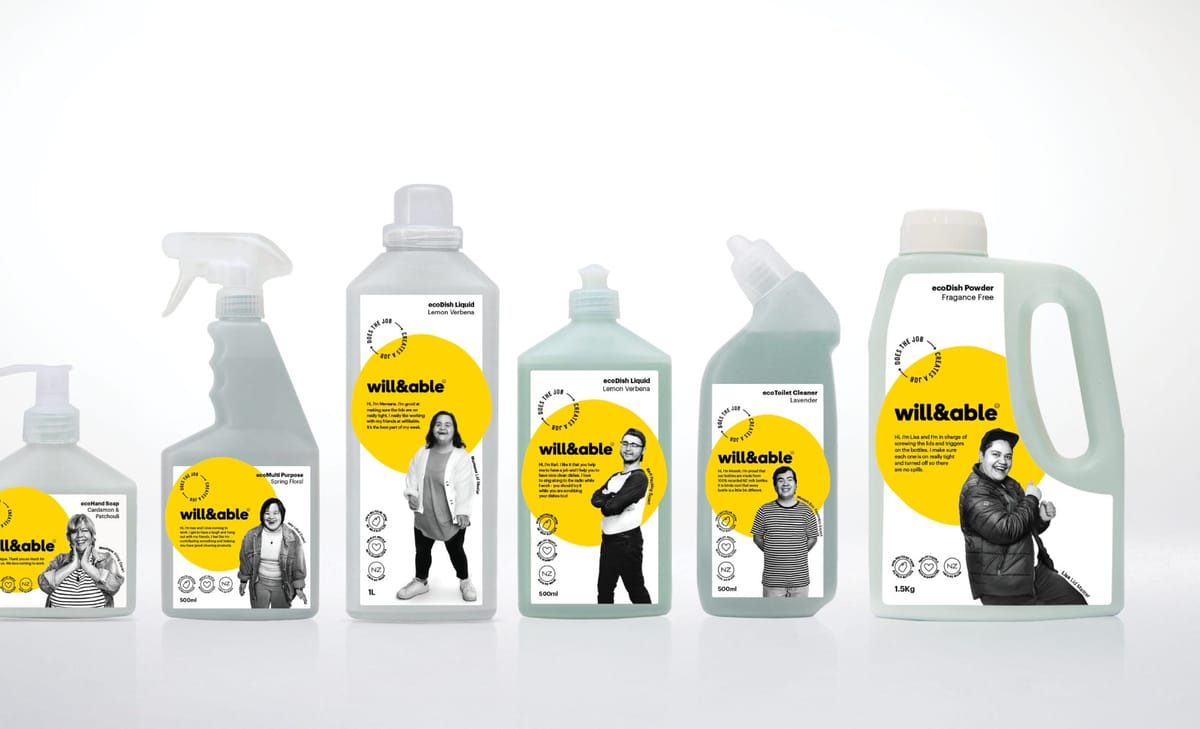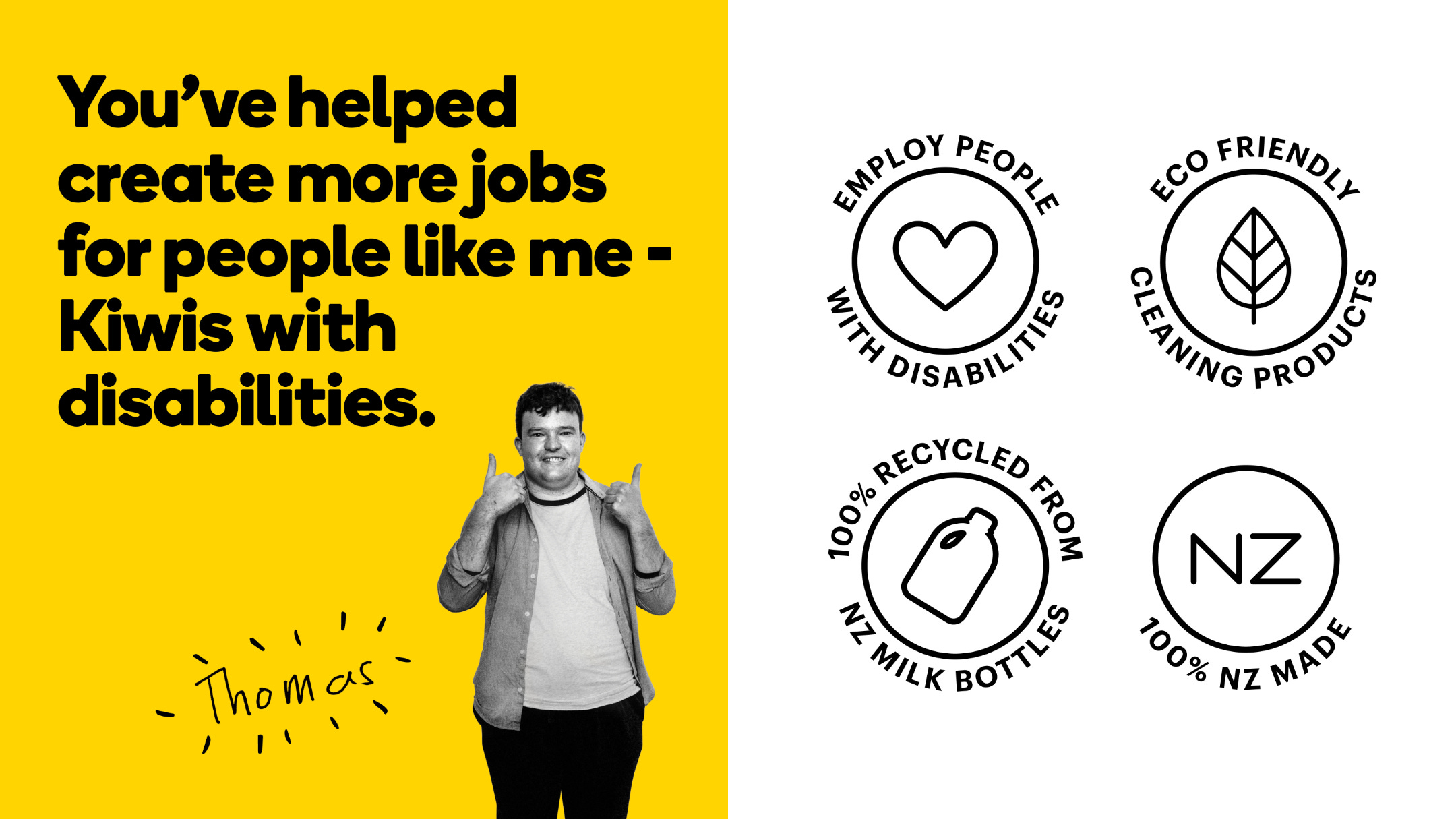Mission Critical
Bringing a social-enterprise business into the mainstream

Last year, Auckland-based design office Shine launched a rebrand of Will & Able, a social-enterprise business that employs Kiwis with disabilities to make and distribute earth-friendly cleaning products. We spoke about the project with Head of Design Danny Carlsen and business strategist Izzi Morris.
Frontier: What state was the business in when its leaders approached you?
Izzi Morris: Funnily enough, my dad started working with their parent company Altus Enterprises years ago, using their team to label the bottles for his company’s cleaning products. After a few years, they realized everyday customers would probably love to directly support a brand that put these employees at the center of the story. Will & Able quickly pulled a brand together and were selling a few thousand dollars of products per month and employing a few people.
Altus Enterprises employs over one hundred people with disabilities and does a lot of B2B contract manufacturing. When New Zealand went into lockdown, Altus had to let go of dozens of people. When a local news program did a segment about the employees with disabilities who might lose their jobs, and suggested that supporting Will & Able could help re-hire some, the company did over $100,000 in sales overnight.
This unlocked huge opportunities for the brand, like the chance to launch in supermarkets and work with corporate sponsors. But they realized that their label designs and brand didn’t fully reflect the company’s incredible ethos. I went to Danny and said, “How can Shine use its design and strategy talents to help?”
Danny Carlsen: Both Izzi and I have a passion for social-enterprise businesses, for transformative social justice, what you call purpose-driven projects. The vision Will & Able has for changing the world is clear. But there was a massive disconnect between that and the brand’s visual communication. This was an opportunity for us to link the two together.
IM: The existing label design had quite a clinical feeling and didn’t really work for a retail environment. But it did have some amazing design elements. The labels already featured pictures of and quotes from the employees. Some of the icons were hand-drawn by the staff. Danny and his team pushed that all to the forefront.
DC: We had a fantastic opportunity to build upon the warmth, friendliness, and authenticity of the brand.
Our job became helping the brand match the company’s ambition: to be in major supermarkets alongside products made by large, international corporations. We wanted to make sure, in a busy retail environment, the design system would be translated to the packaging—to ensure the warmth of the brand would exude from the shelf. This is a circular enterprise that puts people at the center of everything it does. We built a design identity that reflected this vision.
The employees get such joy from their work, from being on the road to independence and financial freedom, that joy had to be part of the project. What better way to celebrate this than with the circle, the enterprise, sunshine, the smile? The simplicity of those elements, and the very graphic way we’ve treated things, mean that it’s so different from everything else on store shelves.

Frontier: Do you think this kind of business succeeds without good branding?
IM: I think the people, and the company’s story, was shared with New Zealand at the perfect moment. They would have grown to be ab amazing business whether or not we brought our skills to the table. But I think great design can dramatically accelerate a business. Social enterprises are going from the fringes to the center of the economy; they’re stealing market share. And right now in New Zealand we seeing new ones emerge in nearly every category—from beer and lunch-delivery companies to body care and cleaning products—and win customers by combining purpose and great design.
DC: I agree. New Zealand punches above its weight in terms of design excellence. There are a few brands out there that could compete with this product based on ingredients and effectiveness. But part of our approach was to emphasize points of difference. Others might have a similar emphasis on sustainability, but Will & Able also has the story of its people. That’s very compelling.
IM: Coming from a strategy background, I’m always thinking about what segment of the market we are tapping into. We know in commodity products that the purchasing decisions of forty or fifty percent of people are driven primarily by price. Only two or three percent are driven solely by purpose or by the background story. The rest in the middle are influenced by a mix of the design, the story, the product benefits, and the value-to-price equation. Will & Able’s previous brand was brilliant at capturing that smaller, solely purpose-driven group. But we wanted to appeal to the millions who want more than just purpose. Design is critical for social-enterprise businesses to grow, to widen their audiences.
Frontier: I’m also aware of the Change Maker project from fellow Auckland studio Milk. Is it coincidence that two large projects for companies dedicated to helping people with disabilities have launched almost simultaneously?
DC: People in New Zealand have always had a sense of justice, of fairness. Maybe it’s in our pioneer roots. We were the first country on the globe to give women the vote; we’ve rallied against nuclear proliferation; I read a story recently that suggests we’re the third-most charitable country, per capita, on Earth. Those things add up to a clear national sense of supporting just causes. In recent years we’re beginning to see that manifest in design. Companies, nonprofits, even government agencies are recognizing the value of positioning their work as relevant, current, and and value- or ethics-driven.
IM: If you want an example of the government’s dedication to this, look no further than the COVID campaign, which emphasized kindness, consistency, and unity. From audio to visuals to copy writing, it’s a brilliant case study in great design. They even made a dubstep version of our director of health’s comments to play at music festivals.
Danny: That was a project with a clear big idea. If we, as designers, can hang everything on a fantastic idea, and support it with beautiful craft, it can be truly transformative for the organization’s or product’s success. The idea behind Will & Able is equally clear and compelling.
Project team:
Head of Design – Danny Carlsen
Strategy – Izzi Morris
Designers – Simone Lash, Vijay Patel
Copywriters – Oliver Green, Briar Wood
Photography – Amber Jones
Animation – Luke Guilford





